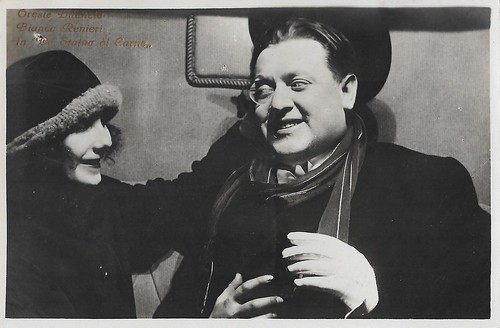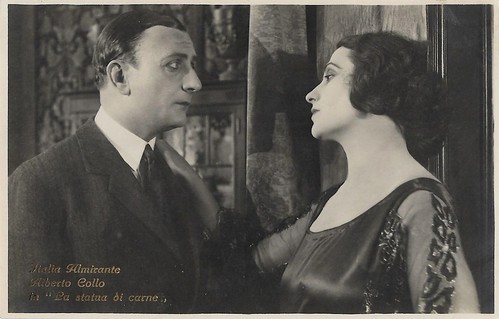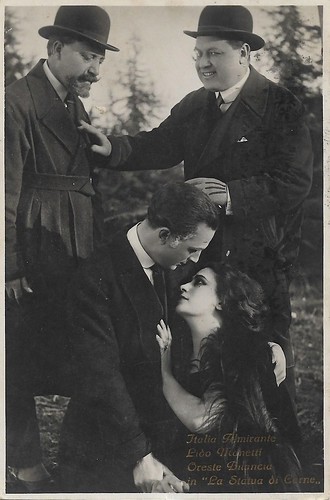La statua di carne/The statue of flesh (1921) is a silent Italian film directed by Mario Almirante. The stars are his wife, diva Italia Almirante Manzini and Lido Manetti a.k.a. Arnold Kent. Italia Almirante plays a beautiful, worldly femme fatale, who falls in love with a man who has drunk all the cups of life. He finds in her, the memory of a dead woman he previously loved and to which the woman looks like a drop of water. He uses her as a statue of flesh.

Italian postcard by G.B. Falci, Milano, no. 213. Italia Almirante, Bianca Renieri, Lido Manetti and Oreste Bilancia in La statua di carne (Mario Almirante, 1921). After a wild night of slumming to chase the bad experience of his infidel upper-class girlfriend, count Paolo di Santa Flora (Manetti) with his rotund friend (Bilancia) meet early in the morning a group of lower-class girls going to work. Among them Maria (Almirante) and her friend (Renieri). The girls adopt the men, thinking they are poor artists, and offer them breakfast.

Italian postcard by G.B. Falci, Milano, no. 215. Oreste Bilancia, Italia Almirante and Lido Manetti in La statua di carne (Mario Almirante, 1921). After their first meeting, Paolo continues the charade to stay close to Maria. He pretends to be a poor artist. His friend knows why.
La statua di carne/The statue of flesh was based on a stage play by Theobald Ciconi, which was adapted by Luciano Doria. The 1862 play had already been brought twice to the screen. The earlier film versions date from 1912 and 1919.
In 1943 director Camillo Mastrocinque implemented a new, naturalistic film edition of the play, La statua vivente/The Living Statue. The leads were played by Fosco Giachetti and Laura Solari.
A restored version of 67 minutes of La statua di carne (1921) was presented to the Pordenone Silent Film Festival of 1991. Another version of 75 minutes was presented by the Bologna Cinematheque at the Cinema Ritrovato festival 2010. Originally, the film was about 80 minutes.

Italian postcard by G.B. Falci, Milano, no. 220. Bianca Renieri, Italia Almirante, Oreste Bilancia and Lido Manetti in the film La statua di carne (Mario Almirante, 1921). Rich but bored Count Paolo (Manetti) and his equally well-to-do friend (Bilancia) pretend to be quite penniless, in order to stay close to the girls of the flower-making atelier, in particular Maria (Almirante) and her friend (Renieri). The men even assist in the shop. From the extreme right to the left, this picture shows Manetti, Bilancia, Almirante, and Renieri working in the shop.

Italian postcard by G.B. Falci, Milano, no. 104. Photo: La Fotominio. Italia Almirante in La statua di carne (Mario Almirante, 1921). Maria secretly visits Paolo's apartment next door and brings him flowers.

Italian postcard by G.B. Falci, Milano, no number. Photo: La Fotominio. Oreste Bilancia and Bianca Renieri in La statua di carne (Mario Almirante, 1921). Paolo's friend reveals to Maria's friend he is not a poor bum but a wealthy aristocrat.

Italian postcard by G.B. Falci, Milano, no. 243. Italia Almirante and Lido Manetti in La statua di carne (Mario Almirante, 1921). Poor Maria is deeply in love with Paolo, at first unknowing he is a count who pretends to be a poor artist. She will die of tuberculosis, at the hands of Paolo.
Italia Almirante (1890-1941) was one of the divas of the Italian silent cinema. She starred in the classic epic Cabiria (1914).
Lido Manetti a.k.a. Arnold Kent (1899-1928) was an Italian actor who first had a prolific career in Italian silent cinema. Brought to America as a young leading man, he died before living up to his promise.
Bianca Renieri (?-1985) had a short but fruitful career in Italian silent cinema in the early 1920s. She worked as a supporting actress and antagonist opposite Francesca Bertini in La ferita (1920), Maddalena Ferat (1920), and Ultimo sogno (1924). Opposite Italia Almirante, she also appeared in I tre amanti (1921), Marthù che visto il diavolo (1921) and La maschera del male (1922). She also acted in films with Linda Pini and Diomira Jacobini, in the propaganda film Il grido dell'aquila (Mario Volpe 1923) and the Za-la-mort crime film Quale dei due? (Emilio Ghione, 1922). Her last part was the female lead in Contessina (Arturo Gallea, 1925).
Oreste Bilancia (1881-1945) was an Italian stage and film actor, who was highly active in Italian silent and sound cinema and German late silent film. He mostly worked as a supporting actor, but occasionally he played the lead.

Italian postcard by G.B. Falci, Milano, no. 94. Photo: La Fotominio. Italia Almirante and Lido Manetti in La statua di carne (Mario Almirante, 1921). Count Paolo's first night back in society after Maria's death provides him with a shock. He meets an elegant masked lady, Noemi Keller, the toast of the town. She agrees to cheer him up. In a room in the theatre, she takes off her mask and proves to be the spitting image of Maria.

Italian postcard by G.B. Falci, Milano, no. 250. Italia Almirante in La statua di carne (Mario Almirante, 1921). Rich, mundane, and femme fatale Noemi Keller considers the offer done to her by count Paolo: to live in a splendid villa and in recompense sit in front of him one hour every day.

Italian postcard by G.B. Falci, Milano, no. 52. Photo: Fotominio. Italia Almirante in La statua di carne (Mario Almirante, 1921). Noemi Keller notices the painted portrait of her lookalike Maria, who has died and whom the painter, count Paolo, is still loving, through Noemi.

Italian postcard by G.B. Falci, Milano, no. 47. Photo: Fotominio. Italia Almirante and Alberto Collo in La statua di carne (Mario Almirante, 1921). Noemi Keller's old flame begs her to give up her charade for Paolo, sitting each day like a statue in front of him, as she is the spitting image of his lost love Maria. But Naomi cannot give up, as she is developing a crush for Paolo.

Italian postcard by G.B. Falci, Milano. Italia Almirante in La statua di carne (Mario Almirante, 1921). Noemi considers whether she should stop the charade for Paolo.

Italian postcard by G.B. Falci, Milano, no. 99. Italia Almirante and Alberto Collo in La statua di carne (Mario Almirante 1921). Noemi Keller's old flame tries to let her give up her golden cage and get back to social life, but she refuses.

Italian postcard by G.B. Falci, Milano, no. 49. Photo: Fotominio. Italia Almirante, Lido Manetti and Oreste Bilancia in the closing scene of La statua di carne (Mario Almirante, 1921). Paolo has fought a duel with Noemi's former lover. Noemi goes berserk when seeing the duel and throws herself in Paolo's arms. He then finally recognizes her as herself and not anymore as the lookalike, and opens his heart to her too. Diplomatically, Paolo's friend takes the doctor away, leaving the couple to themselves.
Sources: Wikipedia (Italian) and IMDb.
This post was last updated on 10 June 2021.

Italian postcard by G.B. Falci, Milano, no. 213. Italia Almirante, Bianca Renieri, Lido Manetti and Oreste Bilancia in La statua di carne (Mario Almirante, 1921). After a wild night of slumming to chase the bad experience of his infidel upper-class girlfriend, count Paolo di Santa Flora (Manetti) with his rotund friend (Bilancia) meet early in the morning a group of lower-class girls going to work. Among them Maria (Almirante) and her friend (Renieri). The girls adopt the men, thinking they are poor artists, and offer them breakfast.

Italian postcard by G.B. Falci, Milano, no. 215. Oreste Bilancia, Italia Almirante and Lido Manetti in La statua di carne (Mario Almirante, 1921). After their first meeting, Paolo continues the charade to stay close to Maria. He pretends to be a poor artist. His friend knows why.
Different versions
La statua di carne/The statue of flesh was based on a stage play by Theobald Ciconi, which was adapted by Luciano Doria. The 1862 play had already been brought twice to the screen. The earlier film versions date from 1912 and 1919.
In 1943 director Camillo Mastrocinque implemented a new, naturalistic film edition of the play, La statua vivente/The Living Statue. The leads were played by Fosco Giachetti and Laura Solari.
A restored version of 67 minutes of La statua di carne (1921) was presented to the Pordenone Silent Film Festival of 1991. Another version of 75 minutes was presented by the Bologna Cinematheque at the Cinema Ritrovato festival 2010. Originally, the film was about 80 minutes.

Italian postcard by G.B. Falci, Milano, no. 220. Bianca Renieri, Italia Almirante, Oreste Bilancia and Lido Manetti in the film La statua di carne (Mario Almirante, 1921). Rich but bored Count Paolo (Manetti) and his equally well-to-do friend (Bilancia) pretend to be quite penniless, in order to stay close to the girls of the flower-making atelier, in particular Maria (Almirante) and her friend (Renieri). The men even assist in the shop. From the extreme right to the left, this picture shows Manetti, Bilancia, Almirante, and Renieri working in the shop.

Italian postcard by G.B. Falci, Milano, no. 104. Photo: La Fotominio. Italia Almirante in La statua di carne (Mario Almirante, 1921). Maria secretly visits Paolo's apartment next door and brings him flowers.

Italian postcard by G.B. Falci, Milano, no number. Photo: La Fotominio. Oreste Bilancia and Bianca Renieri in La statua di carne (Mario Almirante, 1921). Paolo's friend reveals to Maria's friend he is not a poor bum but a wealthy aristocrat.

Italian postcard by G.B. Falci, Milano, no. 243. Italia Almirante and Lido Manetti in La statua di carne (Mario Almirante, 1921). Poor Maria is deeply in love with Paolo, at first unknowing he is a count who pretends to be a poor artist. She will die of tuberculosis, at the hands of Paolo.
The four main stars
Italia Almirante (1890-1941) was one of the divas of the Italian silent cinema. She starred in the classic epic Cabiria (1914).
Lido Manetti a.k.a. Arnold Kent (1899-1928) was an Italian actor who first had a prolific career in Italian silent cinema. Brought to America as a young leading man, he died before living up to his promise.
Bianca Renieri (?-1985) had a short but fruitful career in Italian silent cinema in the early 1920s. She worked as a supporting actress and antagonist opposite Francesca Bertini in La ferita (1920), Maddalena Ferat (1920), and Ultimo sogno (1924). Opposite Italia Almirante, she also appeared in I tre amanti (1921), Marthù che visto il diavolo (1921) and La maschera del male (1922). She also acted in films with Linda Pini and Diomira Jacobini, in the propaganda film Il grido dell'aquila (Mario Volpe 1923) and the Za-la-mort crime film Quale dei due? (Emilio Ghione, 1922). Her last part was the female lead in Contessina (Arturo Gallea, 1925).
Oreste Bilancia (1881-1945) was an Italian stage and film actor, who was highly active in Italian silent and sound cinema and German late silent film. He mostly worked as a supporting actor, but occasionally he played the lead.

Italian postcard by G.B. Falci, Milano, no. 94. Photo: La Fotominio. Italia Almirante and Lido Manetti in La statua di carne (Mario Almirante, 1921). Count Paolo's first night back in society after Maria's death provides him with a shock. He meets an elegant masked lady, Noemi Keller, the toast of the town. She agrees to cheer him up. In a room in the theatre, she takes off her mask and proves to be the spitting image of Maria.

Italian postcard by G.B. Falci, Milano, no. 250. Italia Almirante in La statua di carne (Mario Almirante, 1921). Rich, mundane, and femme fatale Noemi Keller considers the offer done to her by count Paolo: to live in a splendid villa and in recompense sit in front of him one hour every day.

Italian postcard by G.B. Falci, Milano, no. 52. Photo: Fotominio. Italia Almirante in La statua di carne (Mario Almirante, 1921). Noemi Keller notices the painted portrait of her lookalike Maria, who has died and whom the painter, count Paolo, is still loving, through Noemi.

Italian postcard by G.B. Falci, Milano, no. 47. Photo: Fotominio. Italia Almirante and Alberto Collo in La statua di carne (Mario Almirante, 1921). Noemi Keller's old flame begs her to give up her charade for Paolo, sitting each day like a statue in front of him, as she is the spitting image of his lost love Maria. But Naomi cannot give up, as she is developing a crush for Paolo.

Italian postcard by G.B. Falci, Milano. Italia Almirante in La statua di carne (Mario Almirante, 1921). Noemi considers whether she should stop the charade for Paolo.

Italian postcard by G.B. Falci, Milano, no. 99. Italia Almirante and Alberto Collo in La statua di carne (Mario Almirante 1921). Noemi Keller's old flame tries to let her give up her golden cage and get back to social life, but she refuses.

Italian postcard by G.B. Falci, Milano, no. 49. Photo: Fotominio. Italia Almirante, Lido Manetti and Oreste Bilancia in the closing scene of La statua di carne (Mario Almirante, 1921). Paolo has fought a duel with Noemi's former lover. Noemi goes berserk when seeing the duel and throws herself in Paolo's arms. He then finally recognizes her as herself and not anymore as the lookalike, and opens his heart to her too. Diplomatically, Paolo's friend takes the doctor away, leaving the couple to themselves.
Sources: Wikipedia (Italian) and IMDb.
This post was last updated on 10 June 2021.
2 comments:
I saw this film last year in Pordenone and absolutely loved it! Such grand melodramatic fun.
Thanks. This year, I have to be in Pordenone to see the forzuti programme. Luigi Albertini and Carlo Aldini in Germany. I am really looking forward to that programme.
I've added Silents, please! to our blog list.
Post a Comment